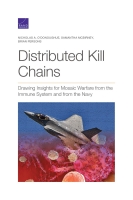by Nicholas A. O'Donoughue, Samantha McBirney, Brian Persons
What are the advantages of Mosaic warfare?
What are potential challenges in the transition to Mosaic warfare?
What changes in the way that systems are procured, evaluated, and fielded might be required to cope with the expected traits of Mosaic warfare?
In Mosaic warfare, individual warfighting platforms are assembled — like the ceramic tiles in mosaics — to make a larger picture or, in this case, a force package. The Defense Advanced Research Projects Agency (DARPA) is developing this novel warfighting construct to acquire, field, and employ forces. To reveal the value of Mosaic warfare and uncover potential challenges in the transition to this system, the authors of this report present a pair of case studies: (1) an analysis of the human immune system's response to pathogens and (2) an analysis of the U.S. Navy's Naval Integrated Fire Control — Counter Air (NIFC-CA) project.
Noting that the human immune system has evolved over 500 million years to exhibit mosaiclike properties — meaning that these properties have conferred some evolutionary advantage — the authors suggest that Mosaic warfare might have similar advantages, such as resilience and adaptability, over other approaches to defeating a threat. They then discuss lessons and best practices from the NIFC-CA project, which largely owes its success to its unique approach to development and fielding. For example, NIFC-CA used preexisting testing infrastructure; approached testing in a scientific manner, in which failure was viewed as a learning opportunity rather than a setback; and had a lengthy development timeline. From these lessons, the authors derive a cohesive set of policy recommendations for DARPA.
Key Findings
The Mosaic warfare system has much in common with the immune system
Both contain many functioning parts, are highly adaptable, and are resilient; there is no single point of failure.
However, with this resiliency comes inefficiency because of possible duplication of effort.
A Mosaic system might be relatively difficult to control; there is no central authority, and there is a large number of platforms to direct.
Robust communication is required because of these systems' disaggregated nature.
A rapid, tailored response to a wide array of possible threats is also necessary.
The NIFC-CA project largely owes its success to its unique approach to development and fielding, which provides several lessons for Mosaic warfare
Structuring NIFC-CA as a project with minimal funding rather than forming a separate program with significant funding resulted in a small increase in funding requirements on the underlying programs — but also allowed NIFC-CA to survive the turbulence of budget cycles and reviews.
NIFC-CA began with three exemplar kill chains and identified a standard for data structures early, which allowed the early use of experiments and ensured that all component programs understood a common data format.
NIFC-CA used the testing infrastructure of preexisting programs instead of creating its own.
Testing was approached in a scientific manner; test failure was seen as a learning opportunity, not a setback.
Like NIFC-CA, which had a lengthy development timeline, the initial Mosaic warfare vision might take some time to field.
Recommendations
Identify pathfinder programs and exemplar vignettes to use as a foil when developing the Mosaic warfare architecture.
Structure acquisition of the Mosaic warfare architecture as a project with pillar programs rather than as a program of record.
Develop algorithms for robust data sharing and distributed processing across large networks of mobile systems.
Develop low-cost rapid manufacturing of platforms and payloads that will make up the Mosaic warfare system.
Develop distributed manufacturing capabilities in order to build the platforms and payloads that will make up the Mosaic warfare system close to where they are needed.
Develop distributed and automated command-and-control algorithms and processes that can translate high-level commands to individual platforms and adapt behavior to changing environments and threat behavior.
Rely on pillar programs to provide early test opportunities, and approach each test event with a willingness to fail and a learning objective.
Develop an approach to test adaptable systems (including artificial intelligence/machine learning algorithms).
Test the resilience of the Mosaic warfare architecture to failure or compromise of component systems.

No comments:
Post a Comment